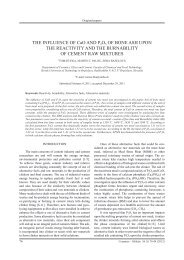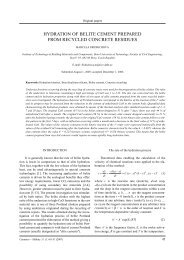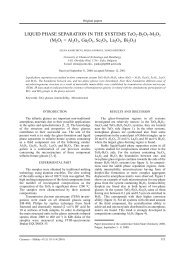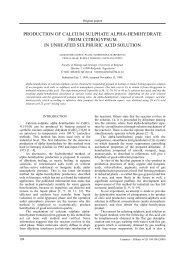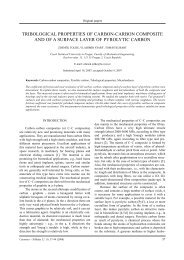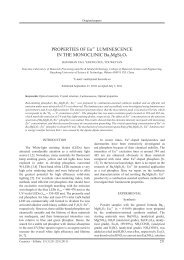Verification of the effect of concrete surface ... - Ceramics-Silikaty
Verification of the effect of concrete surface ... - Ceramics-Silikaty
Verification of the effect of concrete surface ... - Ceramics-Silikaty
Create successful ePaper yourself
Turn your PDF publications into a flip-book with our unique Google optimized e-Paper software.
and simultaneously, <strong>the</strong> pH value <strong>of</strong> <strong>concrete</strong>, which<br />
successfully ensured passivation <strong>of</strong> steel reinforcement<br />
before this input, decreases. This decrease in steel<br />
passivation is in fact <strong>the</strong> worst impact <strong>of</strong> carbonation in<br />
steel reinforced <strong>concrete</strong> [14].<br />
The second stage is mainly characterized by changes<br />
<strong>of</strong> o<strong>the</strong>r hydration products <strong>of</strong> mastic cement, moreover,<br />
due to <strong>the</strong> present humidity and CO 2, <strong>the</strong> resultant CaCO 3<br />
is fur<strong>the</strong>r converted into soluble Ca(HCO 3) 2 according to<br />
<strong>the</strong> equation:<br />
CaCO 3 + CO 2 + H 2O → Ca(HCO 3) 2 (2)<br />
In <strong>the</strong> third stage <strong>of</strong> carbonation, <strong>the</strong> previously<br />
originated carbonate formations recrystallize giving rise<br />
to very large calcite and aragonite crystals. The fourth<br />
stage is typical for its almost 100% carbonation. The third<br />
and fourth stage <strong>of</strong> carbonation worsen substantially <strong>the</strong><br />
strength characteristics <strong>of</strong> <strong>concrete</strong>, <strong>the</strong> pH decreases<br />
markedly; <strong>the</strong> fourth stage can already be a stimulus for<br />
<strong>the</strong> spontaneous destruction <strong>of</strong> <strong>concrete</strong> structure for <strong>the</strong><br />
reason <strong>of</strong> steel corrosion.<br />
The negative <strong>effect</strong>s <strong>of</strong> <strong>concrete</strong> carbonation can<br />
be prevented by designing a very high-quality <strong>concrete</strong><br />
mixture or by its very good compaction during concreting.<br />
As far as older <strong>concrete</strong> structures are concerned, it seems<br />
to be very prospective in <strong>the</strong> light <strong>of</strong> current knowledge,<br />
to protect <strong>the</strong>m additionaly by deep impregnation or<br />
by <strong>surface</strong> coatings on <strong>the</strong> basis <strong>of</strong> waterborne epoxy<br />
dispersions [6, 15]. The main advantage <strong>of</strong> <strong>the</strong> applied<br />
waterborne dispersions <strong>of</strong> epoxy resins, called “ec<strong>of</strong>riendly<br />
coatings” in <strong>the</strong> litrature, is lowering <strong>the</strong> content<br />
<strong>of</strong> solvent evaporation in <strong>the</strong> system. The oldest systems,<br />
<strong>the</strong> so-called dispersions <strong>of</strong> <strong>the</strong> 1 st type, are based on<br />
water-based low-molecular resins. Dispersions <strong>of</strong> <strong>the</strong><br />
2 nd type are based on <strong>the</strong> dispergation <strong>of</strong> a medium or<br />
higher-molecular resin in water, but <strong>the</strong>y contain a certain<br />
amount <strong>of</strong> solvent. The most modern dispersions <strong>of</strong> <strong>the</strong><br />
3rd type are epoxy dispersions containing no or very little<br />
organic solvent. Apart from epoxy resins and epoxymodified<br />
acrylates, <strong>the</strong>y <strong>of</strong>ten include compositions<br />
containing organosilanes. The above mentioned epoxy<br />
dispersions are applied in most cases as two-component<br />
coating compositions. Depending on <strong>the</strong> character <strong>of</strong> <strong>the</strong><br />
initial components, i.e. <strong>of</strong> both <strong>the</strong> dispersion itself, and<br />
<strong>the</strong> hardener, <strong>the</strong> resulting coating films have different<br />
properties.<br />
The main objective <strong>of</strong> <strong>the</strong> research work is to test<br />
<strong>the</strong> positive <strong>effect</strong> <strong>of</strong> waterborne epoxy protective<br />
coatings <strong>of</strong> <strong>the</strong> 2 nd and primarily <strong>of</strong> <strong>the</strong> 3 rd type on<br />
lowering or stopping <strong>the</strong> diffusion and subsequent<br />
permeation <strong>of</strong> <strong>the</strong> aggressive CO 2 into <strong>the</strong> depth <strong>of</strong><br />
cement mortar or <strong>concrete</strong> [13]. The applied coating,<br />
however, should not prevent <strong>the</strong> reverse penetration<br />
<strong>of</strong> moisture from <strong>the</strong> building or from <strong>the</strong> depth <strong>of</strong> <strong>the</strong><br />
structure into <strong>the</strong> atmosphere. In order to determine<br />
<strong>the</strong> susceptibility <strong>of</strong> <strong>concrete</strong> and mortar samples to<br />
carbonation, it can be used <strong>the</strong> procedure based on ČSN<br />
Stehlík M., Novák J.<br />
EN 13 295 „Resistance <strong>of</strong> repair products or systems<br />
to carbonation“, in which <strong>the</strong> test pieces are exposed to<br />
an atmosphere containing 1% CO 2 for <strong>the</strong> period <strong>of</strong> 56<br />
days. However, <strong>the</strong> testing application <strong>of</strong> waterborne<br />
epoxy resins to <strong>the</strong> <strong>surface</strong> <strong>of</strong> <strong>concrete</strong> results in <strong>the</strong><br />
formation <strong>of</strong> a barrier preventing <strong>the</strong> diffusion <strong>of</strong> CO 2.<br />
From this point <strong>of</strong> view, <strong>the</strong> exposition period <strong>of</strong> 56 days<br />
determined by <strong>the</strong> standard in an atmosphere with only<br />
1% CO 2 seems to be very short. The Institute <strong>of</strong> Building<br />
Testing in <strong>the</strong> Faculty <strong>of</strong> Civil Engineering (Brno<br />
University <strong>of</strong> Technology) developed a more suitable<br />
procedure for <strong>the</strong> determination <strong>of</strong> <strong>the</strong> real carbonation<br />
depth. It is an „accelerated carbonation depth test in 98%<br />
CO 2“ [16]. This method is based on <strong>the</strong> finding that <strong>the</strong><br />
speed <strong>of</strong> carbonation in an environment <strong>of</strong> concentrated<br />
98% CO 2 constantly increases in comparison with <strong>the</strong><br />
natural environment containing 0.03% CO 2.<br />
EXPERIMENTAL<br />
The <strong>effect</strong> <strong>of</strong> coating <strong>the</strong> <strong>surface</strong> <strong>of</strong> mortar or <strong>concrete</strong><br />
with waterborne epoxy dispersions on <strong>the</strong> permeability<br />
for <strong>the</strong> aggressive CO2 [15] was tested on standard<br />
mortar beams with dimensions <strong>of</strong> 40×40×160 mm, made<br />
mostly according to <strong>the</strong> three basic formulations labeled<br />
1, 2 and 3 - see Table 1.<br />
After stripping <strong>of</strong>f, <strong>the</strong> mortar beams according to<br />
<strong>the</strong> formulations 1, 2 and 3 were placed under water for<br />
28 days, and <strong>the</strong>n <strong>the</strong>ir moisture content was modified<br />
to approximately 1% <strong>of</strong> moisture by gradual drying out<br />
in <strong>the</strong> laboratory. The following four combinations <strong>of</strong><br />
waterborne dispersions including hardeners were applied<br />
separately to a selected number <strong>of</strong> standard mortar beams<br />
according to <strong>the</strong> formulations 1, 2 and 3 [3, 15]:<br />
a) coating A - 2 layers <strong>of</strong> dispersion CHS Epoxy 200 V<br />
55 + hardener Telalit 180,<br />
b) coating B - 2 layers <strong>of</strong> dispersion DOW XZ 92533 +<br />
+ hardener XZ 92441.01,<br />
c) coating C - 1 layer <strong>of</strong> dispersion CHS Epoxy 200 V<br />
55 + hardener Telalit 180 and 1 layer <strong>of</strong><br />
dispersion Epostyl 217 V,<br />
d) coating D - 2 layers <strong>of</strong> dispersion Epostyl 217 V.<br />
The resin used for <strong>the</strong> <strong>surface</strong> protection CHS<br />
Epoxy 200 V 55 is <strong>the</strong> water dispersion <strong>of</strong> a medium<br />
molecular weight epoxy resin. The system consists <strong>of</strong><br />
a modified epoxy resin and a special hardener Telalit<br />
180. The viscosity <strong>of</strong> <strong>the</strong> resin (25°C) ranges from 0.1-<br />
0.7 Pa.s according to DIN 53015. The content <strong>of</strong> nonvolatile<br />
matters (2 h/140°C) varies from 54-58 wt.%<br />
in accordance with ISO 3251. The hardener Telalit 180<br />
is a universal hardener for CHS Epoxy waterborne<br />
epoxy systems. Telalit 180 is a water-based solution<br />
<strong>of</strong> an epoxy-polyamine adduct. Its viscosity (25°C)<br />
ranges from 0.75-1.1 Pa.s according to DIN 53015.<br />
The recommended mixing ratio <strong>of</strong> CHS Epoxy 200<br />
V 55 : Telalit 180 is 100pbw. : 27pbw.<br />
80 <strong>Ceramics</strong> – Silikáty 55 (1) 79-84 (2011)



